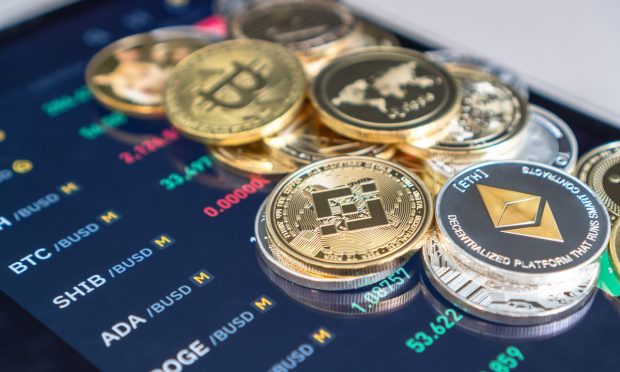Crypto Fundamentals: How Do Exchanges Make Money?

Welcome to the first in PYMNTS’ series on the fundamentals of the crypto industry. In it, we’ll be looking at how the market works and doesn’t work, the various firms and players that make it go, and the rules of the road that — ideally — keep it flowing smoothly.
So, how do cryptocurrency exchanges make money?
Well, at their core, crypto exchanges make money off trading fees: When you buy or sell something, you pay the exchange a cut. These vary drastically by the size of the trade and often by the trader’s monthly volume — and, of course, there are withdrawal fees for off-ramping funds.
Clients also pay the blockchain trading fees, but those don’t go to exchanges.
It’s also worth noting that we’re talking about centralized exchanges like Binance, Coinbase and FTX, not decentralized finance’s (DeFi’s) decentralized exchanges, known as DEXs.
The popular, publicly listed Coinbase exchange’s fees start at 1% — 0.6% for the taker and 0.4% for the maker up to $10,000. At the far end, $500 million-plus, takers pay $0.05 and makers nothing. By contrast, top global exchange Binance’s fees start at 0.1% for the maker and the taker — and drop to 0.04% for the taker and 0.02% for the maker.
See also: Swiss Regulators Want More Protections for Crypto Investors
Exchanges with a strong reputation, user-friendly interface and a high profile have been able to attract higher fees.
Still, as trading volumes drop and crypto winter sets in, they’re making less money. A volatile market — and crypto is in the best of times — is good for exchanges as it encourages traders to play the market. A steady down market, on the other hand, discourages trading.
Those have dropped substantially. The Block put crypto’s monthly trading volume at a high of $2.23 trillion in May 2021, at the height of the year’s first bull market, dipping to $670 billion that July and rising to $1.4 trillion in November’s second bull market. This June, it was $622 billion.
It, like most other major exchanges, has high-service over-the-counter (OTC) desks that handle trades privately for institutional clients. Fees are generally lower than standard trades, but can be negotiated client by client.
It’s happening across the crypto industry, according to a recent report by Glassnode. Down almost 38% in June, bitcoin shows on-chain activity — or bitcoin moving from one wallet to another — off 13% from November’s highs at the height of the bull market.
Related: Crypto’s Celebrity Endorsements Attract Customers, Repel Critics
“Bitcoin has seen a near complete expulsion of market tourists, leaving the resolve of HODLers as the last line standing,” Glassnode said. HODLers — meaning hardcore bitcoin and crypto believers who “Hold On for Dear Life” — don’t tend to sell, however.
And the fee decline could be getting worse — for the moment at any rate.
On June 22, Bloomberg reported that Binance.US, the firm’s American exchange, may be starting a price war, or joining one started by Robinhood, by moving to zero fees — which the biggest and richest exchange, by far, can afford in pursuit of customer acquisition.
This can be offset by making money on the bid-ask spread or — as Robinhood showed in the GameStop debacle — by routing orders to fee-paying paying market makers.
Lending
Aside from trading fees on spot and derivative trades, exchanges make money by lending to margin traders, earning interest and liquidation fees when margin calls are missed — something that happens very frequently, given crypto’s volatility.
They have also been making good money on “Earn” accounts, also known as lending borrowing platforms, in which crypto owners are given very high interest rates to lock in funds that the exchanges — and standalone lending firms — loan out at high rates or sometimes invest in DeFi and centralized staking programs.
The Securities and Exchange Commission (SEC) is trying to change that, having warned Coinbase not to start one in November. The SEC also settled a lawsuit against a standalone crypto lending firm, BlockFi, for $100 million earlier this year.
Read more: BlockFi’s $100 Million Settlement With SEC Raises Internal Discussion
Sketchy
SEC Chairman Gary Gensler has accused crypto industry exchanges of a number of questionable practices, notably market making against customers and front-running trade orders.
Exchanges are “trading against their customers often because they’re market-marking against their customers,” Gensler recently testified in a House Financial Services Committee hearing asking for tougher regulation and more authority for his agency. “Without a cop on the beat and some rules of the road, then market participants can front-run your orders.”
Services
The bigger crypto exchanges have been issuing Visa- and Mastercard- branded debit cards that allow users to spend crypto at online and brick-and-mortar merchants. That earns withdrawal fees in addition to any card-related fees.
Many exchanges offer professional custody services. Coinbase Custody is an independent, separately regulated entity catering mostly to large and institutional clients.
Tokens
A number of exchanges have their own exchange tokens that offer discounts on trades and other fees when customers use them to buy and sell.
Binance was an early leader with its utility token, BNB. That has since expanded dramatically when Binance created its own blockchain, Binance Smart Chain, later renamed BNB Chain, which uses BNB for on-chain transaction fees.
Other
Many exchanges launch investment arms that are essentially seed and venture capital firms, and a growing number are launching non-fungible token (NFT) marketplaces.
Sign up here for daily updates on all of PYMNTS’ crypto coverage.
